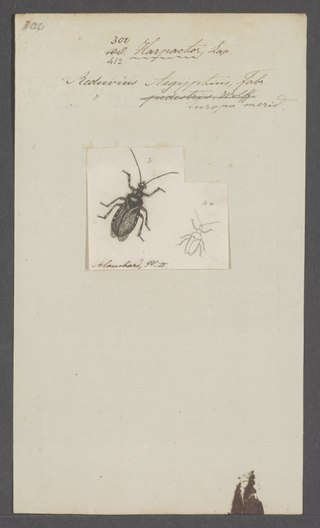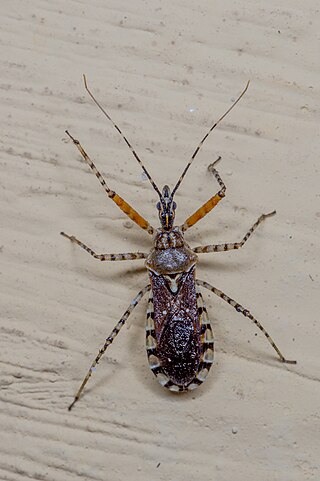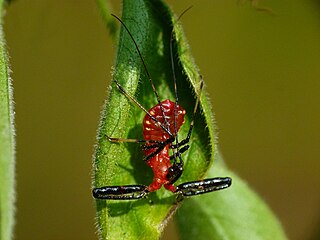
Eggplant, aubergine, brinjal, or baigan is a plant species in the nightshade family Solanaceae. Solanum melongena is grown worldwide for its edible fruit.

Solanum is a large and diverse genus of flowering plants, which include three food crops of high economic importance: the potato, the tomato and the eggplant. It is the largest genus in the nightshade family Solanaceae, comprising around 1,500 species. It also contains the so-called horse nettles, as well as numerous plants cultivated for their ornamental flowers and fruit.

Zelus is a genus of insects in the family Reduviidae, the assassin bugs. There are currently 60 described species; most occur in Central and South America, and five are found in North America.

The Harpactorinae are a large subfamily of the Reduviidae. About 300 genera and 2,000 species worldwide have been described. Some of the species of the genera Zelus, Pselliopus, Sinea, and Apiomerus are of interest as biological pest control agents.

Harpactor is a genus of assassin bug family (Reduviidae), in the subfamily Harpactorinae.
Harpactor angulosus is a species of true bug (Harpactorinae). This assassin bug has been documented preying on caterpillars of the genus Hylesia in Viçosa, Minas Gerais State, Brazil. Caterpillars of this genus are an agricultural pest. H. angulosus, like other species of Harpactorini, has potential as a biological pest control agent.

Euagoras is a genus of assassin bugs, in the subfamily Harpactorinae. Species are found in Asia and Australia.

Cosmoclopius nigroannulatus is a species of assassin bug family (Reduviidae), in the subfamily Harpactorinae. It is a predator of pests in tobacco fields. Its main prey is the tobacco grayish bug, Spartocera dentiventris Berg.
Rhynocoris tristis is a species of assassin bug family (Reduviidae), in the subfamily Harpactorinae. R. tristis is a polyphagous predator found in sub-Saharan Africa.

Pselliopus is a common genus of assassin bugs (Reduviidae), in the subfamily Harpactorinae. The genus is restricted to the New World, with 27 species described. Some species, such as Pselliopus barberi, are conspicuous because of their bright coloring and relatively large size. Some species of the genus are of interest as potential biological pest control agents.

Zelus longipes is an assassin bug (Reduviidae) that is a member of the Harpactorinae subfamily. Its distribution ranges include southern North America, Central America, and South America, especially in agroecosystems in Brazil.

The South American potato tuber moth, Andean potato tuber moth or tomato stemborer is a moth of the family Gelechiidae. It is native to South America, but has become a pest worldwide. Records include North America, Australia and New Zealand.

Conogethes punctiferalis, the durian fruit borer or yellow peach moth, is a moth of the family Crambidae.

Zelus renardii, commonly known as the leaf hopper assassin bug, is a predacious insect contained within tribe Harpactorini. Diurnal and found on both wild and crop plants, Z. renardii has spread from its native habitats in western North and Central America into three other biogeographic regions across the globe.

Solanum caripense is a species of evergreen shrub native to South America and grown for its edible fruit.
Solanum candidum is a species of evergreen shrub native to South America and occasionally grown for its edible fruit.
Solanum repandum is a species of evergreen shrub native to various island groups across the Pacific Ocean, and occasionally grown for its edible fruit.

Acizzia solanicola is a psyllid from Australia, found on plants of the genus Solanum. It has subsequently been found also in New Zealand.

Rihirbus is a genus of assassin bug from the tropical parts of the Oriental region. They belong to the Harpactorinae and the genus is unique in having the fore tibiae with incurved tips and the apex having a long tooth. They show sexual dimorphism and are polymorphic making their identification to species complicated. Females are larger and wider. R. trochantericus takes about 49 days to develop from egg to adult in southern India.
Myllocerus viridanus, often known as sweet potato beetle, pod borer or ash weevil, is a species of weevil native to India and Sri Lanka.













